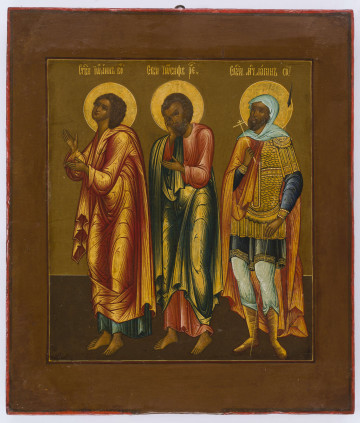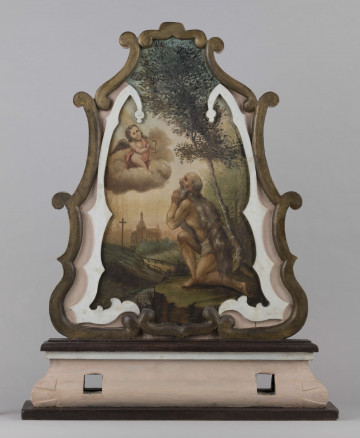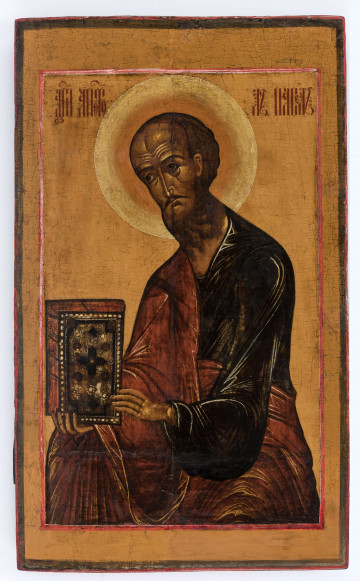
Ascension / Saints John, Joseph and Longinus
1801 — 1900
National Museum in Lublin
Part of the collection: Icons
The icon of St. Charalampus, bishop of Mainz, tells the story of his martyrdom in 202 CE and of the miracles he performed. The scenes are presented in twelve Клейма (quarters around the main stage) and in the centre of the icon. They should be read from left to right, with the last scene being the one in the central field.
The story of his martyrdom begins with him being accused of proclaiming Christianity, facing the emperor Lucian (1). The emperor condemns the bishop to torment by flaying (2), but immediately the torturers are punished – the emperor’s hands (still clamped on the hooks) hang in the air, the governor’s head is turned face back (3). The legend has it that the saint healed the torturers who despite that continued the torture – he was dragged by the chin along the road (4), burned with fire and stabbed with spears (5). In the next scene (6), Charalampus again proves his supernatural powers, heals the possessed (a man with a twisted mouth out of which sketched devilish figures rise up) and resurrects the dead. The saint is again subjected to torment – he is stoned, but he does not stop praying for the tormentors (7) who are punished yet again (8) – the emperor and the soldier hang in the air and are brought back to the ground only due to the intercession of the saint. Galina, the Emperor’s daughter, converts, and in gratitude for releasing her father she bows to Charlampus. She has a vision, and describes it to the emperor (9) – a withered tree miraculous revived of by the saint (10). Still the ruler condemns him to be beheaded (11), and the bishop’s soul – represented twice (as a reduced figure in bishop’s robes and as a naked figure with a halo) – goes to heaven, where Christ awaits him (12). In the central scene, entitled ‘the image of the life and suffering of the holy martyr Charlampus’, the saint asks Christ to protect the earth, where his body will rest.
The icon, created in the workshops of Vietka (now Belarus), is characterised by the exquisite craftsmanship, rich contrasting colours and decorativeness typical of these studios. The cartouche, visible in the centre, is created based on a rocaille-type ornament, is an interesting example of the influence of ornamentation on icon painting.
Author / creator
Dimensions
cały obiekt: height: 43,5 cm, width: 52,5 cm
Object type
painting
Technique
gilding
Material
plank, tempera, gold
Creation time / dating
Creation / finding place
Owner
The National Museum in Lublin
Identification number
Location / status

1801 — 1900
National Museum in Lublin

1864
National Museum in Lublin

1801 — 1900
National Museum in Lublin
DISCOVER this TOPIC
National Museum in Szczecin
DISCOVER this PATH
Educational path